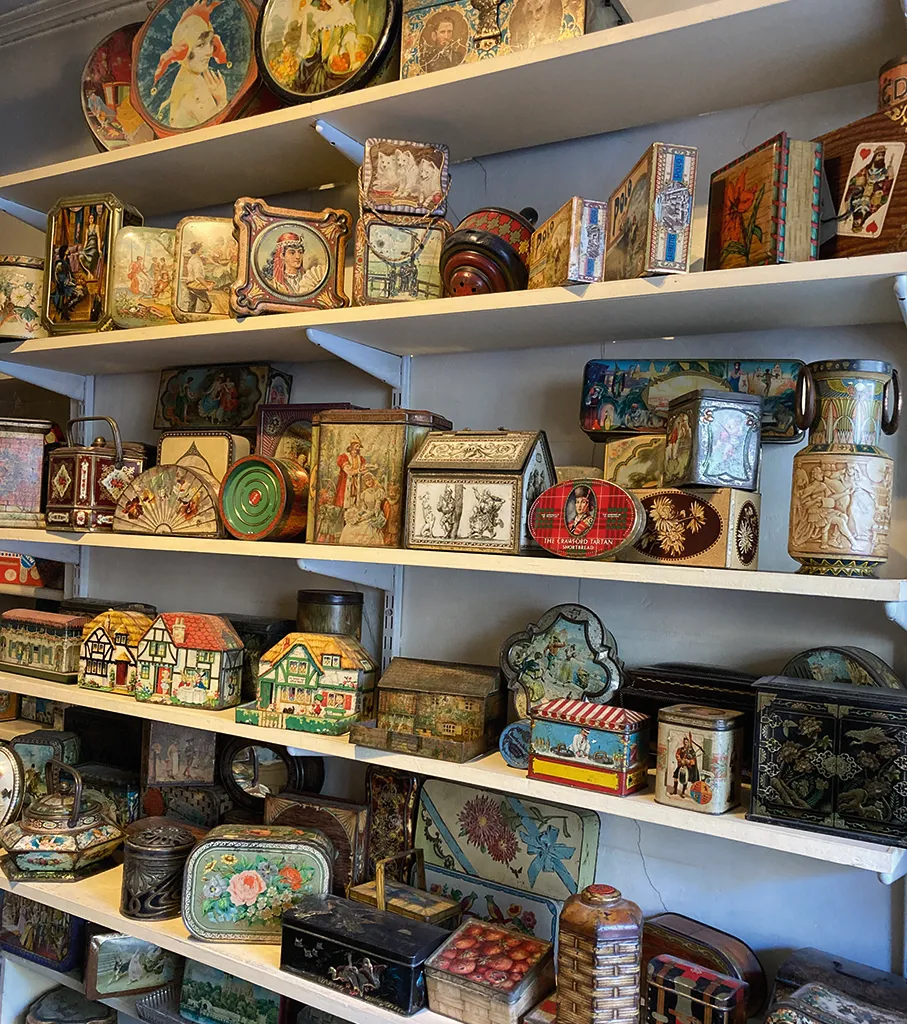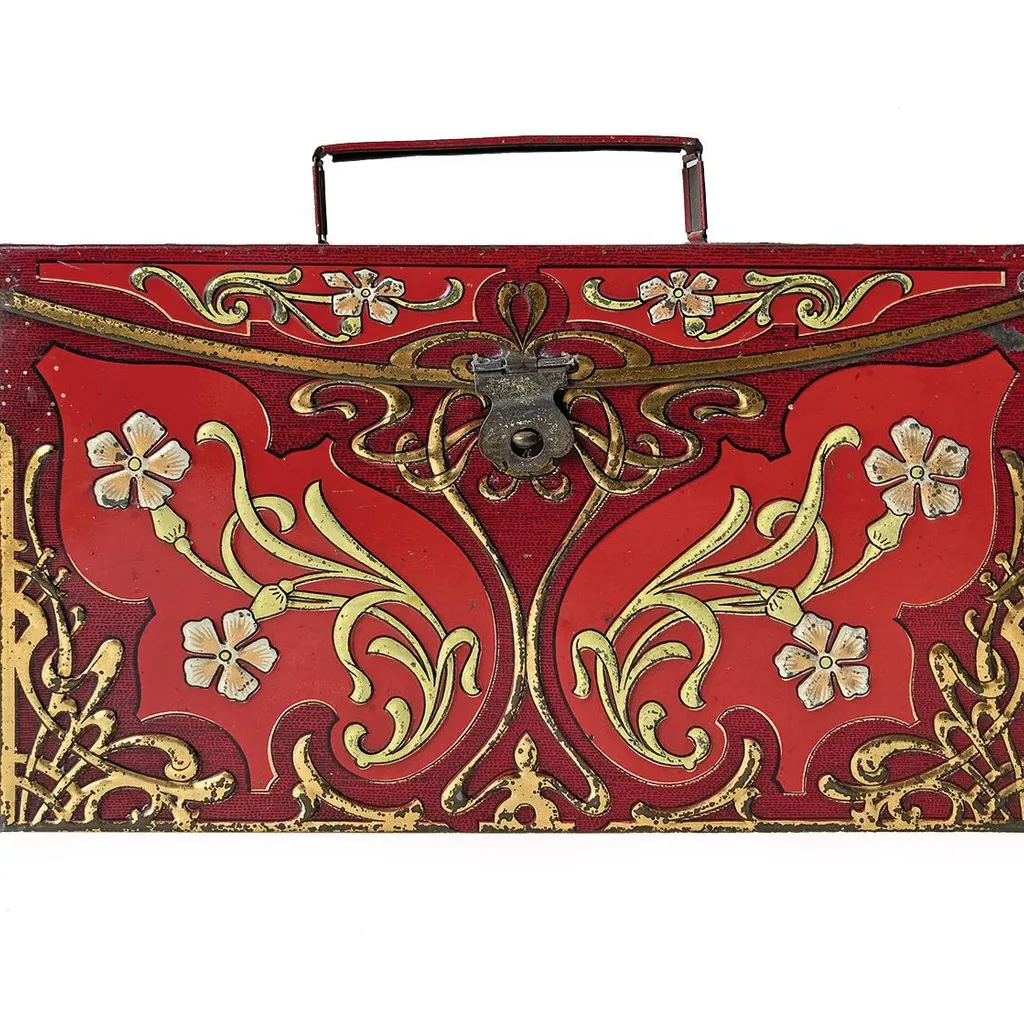It is perhaps the most infamous tale in biscuit tin history… a colourful, old-fashioned tea party adorns the lid of a classic biscuit tin. The quaint design, inspired by the work of Victorian illustrator Kate Greenaway, conjures a scene of cosy nostalgia. But a closer look at the image reveals details that are less than wholesome, from lewd goings-on in the bushes to a jar of something questionable on the table. These additional flourishes turned out to be the work of a mischievous freelance designer, but the tins reached the shelves before the offending details were spotted and production was swiftly halted.

Although not antique – it was made in 1980 – this tin is understandably one of the most noteworthy among collectors today, and examples routinely fetch upwards of £100 (though they can also be found for less). This tin was made by biscuit manufacturer Huntley & Palmers and, although this marks a colourful episode in the company’s history, its part in the story of biscuit tins goes much further than this one risqué collectable. Indeed, Huntley & Palmers has been at the forefront of biscuit tin innovation since the market’s inception, and its designs are among the most coveted today for their beauty and originality.

The 19th century saw the first mass production of sweet biscuits, and companies such as Crawford’s, Jacobs and Peek Frean began to spring up, offering an ever-wider selection of biscuit choices as demand soared. Huntley & Palmers opened in Reading in 1822 and by the early 1830s was the first company to use metal tins to supply its product – this had the dual benefit of keeping the produce fresh while advertising the brand. These early tins, designed for grocers, were square, 7lb or 10lb containers with glass-inset tops.
It was the Licensed Grocer’s Act of 1861 that enabled biscuits to be sold as individually packaged goods and started the trend for decorative gift tins, while the invention of offset lithography in 1877 made it possible to print onto more complex metal shapes. By the turn of the century, biscuit manufacturers were taking full advantage and creating biscuit tins in increasingly ambitious shapes and designs, from globes and grandfather clocks to planes and cars. The tins became masterpieces in their own right, with design ingenuity peaking around the 1920s and 30s.

Unsurprisingly, it is these novelty-shaped tins that attract the most attention today (who wouldn’t love to own a biscuit tin that doubles as a fully working toy sports car?) but the more traditional shapes and styles also have their own appeal and are more widely available. Biscuit tins are a fertile field for collectors, and options abound for all budgets and tastes. ‘Biscuit tins offer a certain sense of nostalgia,’ says Lisa Lloyd, antiques expert and owner of antiques shop Hand of Glory in Wiltshire. ‘They can also be an inexpensive area in which to start collecting – there is lots of variety in the lower end of the market, with prices starting at just a couple of pounds.’
It’s an accessible market with an obvious appeal, agrees Steve Fulford of Hansons Auctioneers: ‘Antique biscuit tins are often very attractive and colourful, and they make a great display if you have space for them.’ With so many options available, it can be difficult to know where to begin a collection. Steve suggests starting with a theme, such as transport or animals, or focusing on a specific brand – Huntley & Palmers being the most prolific, having released around 400 designs between 1868 and the start of the Second World War.

Lisa Lloyd has some more wise words for anyone considering a collection in this field: ‘Buy what you love, rather than buying with the hope of an increase in value. Always buy the best example you can afford and remember that condition is paramount.’ Dented or rusted lithographed metal tins tend to be less desirable – although it does mean that interesting tins can be picked up cheaply if you don’t mind taking on an example that’s not in peak condition.
The biscuit tins that achieve the very highest prices are testament to the fact that condition is key in this market. Pristine tins – especially those in their original boxes – can reach over £1,000. In 2019 a rare, boxed Huntley & Palmers double- decker clockwork bus tin sold at Hansons for £2,500, while the most expensive biscuit tin to date is thought to be a 1920s William Crawford & Sons tin, which sold at Bonhams for £15,600 in 2007. The tin, shaped like a sports coupe car, was not only in pristine condition, but even included its original contents of shaped biscuits still wrapped in greaseproof paper.
But not all novelty-shaped biscuit tins demand such lofty figures. Interesting tins can be found for between £100 and £500 and, if you’re happy to limit yourself to more conventional styles and shapes, it’s possible to find antique and vintage biscuit tins for just a few pounds in antiques shops and online.
Where to buy vintage and antique biscuit tins
Michael Saffell Antiques
3 Walcot Buildings, London Rd, Bath, BA1 6AD. 01225 315857
Below Stairs of Hungerford
Antique tins are often sold through auction houses, while Etsy and eBay are good hunting grounds at the lower end of the market. belowstairs.co.uk
Where to see vintage and antique biscuit tins
Museum of Lithographed Tin Boxes
More than 60,000 tins on display, including biscuit tins, at this museum in Belgium. By appointment only. +32 19 63 43 92
Reading Museum
The Huntley & Palmers gallery includes a vast range of tins from the company’s long history. readingmuseum.org.uk

